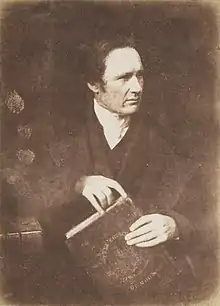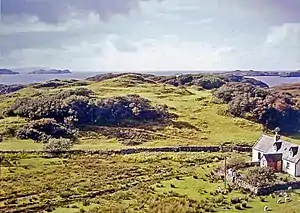Mackintosh MacKay
Mackintosh MacKay (1793 – 1873) was a Scottish minister and author who served as Moderator of the General Assembly of the Free Church of Scotland in 1849. He edited the Highland Society's prodigious Gaelic dictionary ('Dictionarium Scoto-Celticum)[2] in 1828.
Mackintosh MacKay | |
|---|---|
 Mackintosh Mackay from Disruption Worthies of the Highlands[1] | |
| Personal details | |
| Born | 1793 |
| Died | 1873 |

Early life and education
MacKay was born on 18 November 1793 at Duardbeg on Edrachillis Bay in Sutherland, one of seven children to Cpt Alexander Mackay and his wife Helen, daughter of Alexander Falconer, minister of Eddrachillis.[3] He studied at St Andrews University then at Divinity Hall in Edinburgh. After he was licensed by the Presbytery of Skye, he was employed as a schoolmaster at Portree. He was ordained to Laggan 28 September 1825.[4]
In the year 1825 he was appointed minister of Laggan parish, where he remained till 1832, when he was appointed minister of the united parishes of Dunoon and Kilmun. Such was his success there that he soon had the Dunoon church enlarged, Kilmodan erected into a separate parish, and two mission churches appointed—one at Toward and the other at Ardentinny. It was while here that he edited the works of Rob Donn, the Sutherlandshire bard, which were published in 1829. He supplied a biography of the bard, which has given rise to much controversy.[5] He was awarded a LL.D. from Glasgow University in 1829. At Laggan Manse William Forbes Skene, Historiographer-Royal for Scotland, then a youth of nineteen, studied Gaelic under MacKay's tuition. He was subsequently presented by George William, Duke of Argyll, August 1831 and translated and admitted to Dunoon on 19 April 1832.[4]
His 27 February 1840 Address to the Parishioners of Dunoon and Kilmun, given from the Manse in Dunoon, was published later that year. An 1842 addendum by MacKay was later included.[6]
Post Disruption
At the Disruption in 1843 he gave up one of the best livings in the Church of Scotland and joined the Dissenting party. Between 1844 and 1847 he spent much of his time visiting the Highlands and Islands in the yacht "Breadalbane", preaching to the people, and at the same time writing for and editing the Gaelic organ of the Free Church—An Fhianuis. Of this publication 37 parts appeared, dating from 1845 to 1850.[5]
During the distress in the Highlands in 1846-7-8, consequent on the failure of the potato crop, he brought the condition of his fellow Highlanders before the General Assembly of the Free Church, with the result that upwards of £15,000 was collected for their relief. He also did much in the way of providing bursaries for Highland students, and with the assistance of the Ladies' Society of the Free Church he had a number of schools established in remote parts of the Highlands and Islands.[5]
MacKay was elected moderator of the Free Church General Assembly on 24 May 1849, succeeding Patrick Clason of Buccleuch Church in the role. The Assembly was held at Tanfield Hall in Canonmills.[7] He was succeeded in turn by Nathaniel Paterson in 1850.
In the early 1850s he travelled to Australia to spread the views of the Free Church.[8] He became minister of the Gaelic Church, Melbourne, Australia, 1854-1856. He was elected minister of St George's Presbyterian Church, Sydney, New South Wales, in May 1856, being responsible for its first permanent purpose-built church in 1860.[9] He continued there from 1856-61.
Returning home he took up a post in Free Church, Tarbert, Harris, 1862-1868. He died at 3 Bellfield, Portobello, 17 May 1873. He is buried in Duddingston Kirkyard in south Edinburgh. The grave lies against the western boundary wall. A secondary memorial exists to MacKay in Grange Cemetery reasserting his burial in Duddingston.
Relation with Sir Walter Scott
He was a notable Gaelic scholar and preacher. He was intimate with Sir Walter Scott, who describes him as "modest, intelligent, and gentle." "It being Sunday, he favoured us [at Abbotsford] with an excellent discourse on the Socinian controversy, which I wish my friend Mr Laidlaw had heard."[4]
Family
He married 22 February 1828, Frances (died 23 March 1877), daughter of Francis Burton, Edinburgh, and had issue —
- a son, born 23 January, and died 23 March 1829.[4]
Publications
- Dictionarium Scoto-Celticum: A Dictionary of the Gaelic Language (as editor)(1828) (the first Gaelic dictionary to contain 'Vocabularies of Latin and English Words')
- Memoir of Robert Donn
- Exposition of Matthew 5
- Statistical Account of the United Parishes of Dunoon and Kilmun[10]
- Memoir of Rob Donn, and Observations on his Character and Poetry (Inverness, 1829)
- Four Single Sermons (Liverpool and Greenock, 1833-46)
- Sermons, on the Christian Warfare and Titles of Christ (Edinburgh, 1836)
- The Treasure: A Selection from the Olney Hymns (Gaelic) (Glasgow, 1835)
- Address to the Parishioners of Dunoon and Kilmun (Greenock, 1 840)
- Practical Exposition of Matthew V., 1-10, 2 vols. (Edinburgh, 1845)
- Martyrdom of John Brown (Edin., 1846)
- Address to the General Assembly of 1849 (Edin., 1851)
- Sermon Preached before the General Assembly (Edin., 1851)
- Scots Worthies and Church History (London, 1872)
- Sermon on the Decease of the Rev. Roderick Macleod \Bracadale\ with Memorials of his Life, Character, and Ministry (Edinburgh, 1869)
- Account of the Parish (New Stat. Account)
- History of the Church (Gaelic), Description of the Hill-Fort of Dun-da-Laimh, in the Parish of Laggan " (Trans. Arch. Soc, iv.)
- edited An Fhianuis (The Witness), 1845-50.
- He superintended the printing of the Highland Society's Dictionarium-Scoto-Celticum, 2 vols. (Edinburgh, 1828)[4]
Bibliography
- Cameron's Centenary History of the Presbyterian Church in New South Wales, i., 56, 63, passim (Sydney, 1905)
- Maclean's Typographia-Scoto-Gadelica, 236
- Sir Walter Scott's Journal, 124, 206, 406-7
- The Quarterly Review (July 1831)[4]
Gallery
 MacKay’s birthplace at Edrachillis Bay
MacKay’s birthplace at Edrachillis Bay The grave of Very Rev Mackintosh MacKay, Duddingston Kirkyard
The grave of Very Rev Mackintosh MacKay, Duddingston Kirkyard The memorial to Mackintosh MacKay, Grange Cemetery, Edinburgh
The memorial to Mackintosh MacKay, Grange Cemetery, Edinburgh
References
- Citations
- Kennedy 1877.
- MacKay 1828.
- "Mackintosh Mackay, Rev. Dr". geni_family_tree.
- Scott 1923.
- Fionn 1908.
- Address to the Parishioners of Dunoon and Kilmun, J. Hislop (1840)
- "SCOTLAND. » 2 Jun 1849 » The Spectator Archive". The Spectator Archive.
- "Jubilee History of St. Andrew's Presbyterian Church of Carlton". www.electricscotland.com.
- "About Us". www.stgeorgespcea.org.au.
- Colegate's Guide to Dunoon, Kirn, and Hunter's Quay (Second edition) - John Colegate (1868), page 35
- Sources
- Bell, Alan (2004). "Mackay, Mackintosh". Oxford Dictionary of National Biography (online ed.). Oxford University Press. doi:10.1093/ref:odnb/17560. (Subscription or UK public library membership required.)
- Fionn (1908). Mackay, John (ed.). "Gaelic Men of Letters. XI. Rev. Mackintosh Mackay, LL.D". The Celtic Monthly: A Magazine for Highlanders. XVI (11): 214-215.
 This article incorporates text from this source, which is in the public domain.
This article incorporates text from this source, which is in the public domain. - Kennedy, John (1877). Disruption worthies of the highlands. Edinburgh: J. Greig & Son. pp. 79-88.
- Mackay, Aeneas James George (1893). "MacKay, Mackintosh". In Lee, Sidney (ed.). Dictionary of National Biography. Vol. 35. London: Smith, Elder & Co.
- MacKay, Mackintosh, ed. (1828). Dictionarium scoto-celticum : a dictionary of the Gaelic language : comprising an ample vocabulary of Gaelic words, as preserved in vernacular speech, manuscripts, or printed works, with their signification and various meanings in English and Latin, illustrated by suitable examples and phrases, and with etymological remarks, and vocabularies of Latin and English words, with their translation into Gaelic : to which are prefixed, an introduction explaining the nature, objects and sources of the work, and a compendium of Gaelic grammar. Edinburgh: W. Blackwood.
- Scott, Hew (1923). Fasti ecclesiae scoticanae; the succession of ministers in the Church of Scotland from the reformation. Vol. 4. Edinburgh: Oliver and Boyd. p. 24.
 This article incorporates text from this source, which is in the public domain.
This article incorporates text from this source, which is in the public domain.